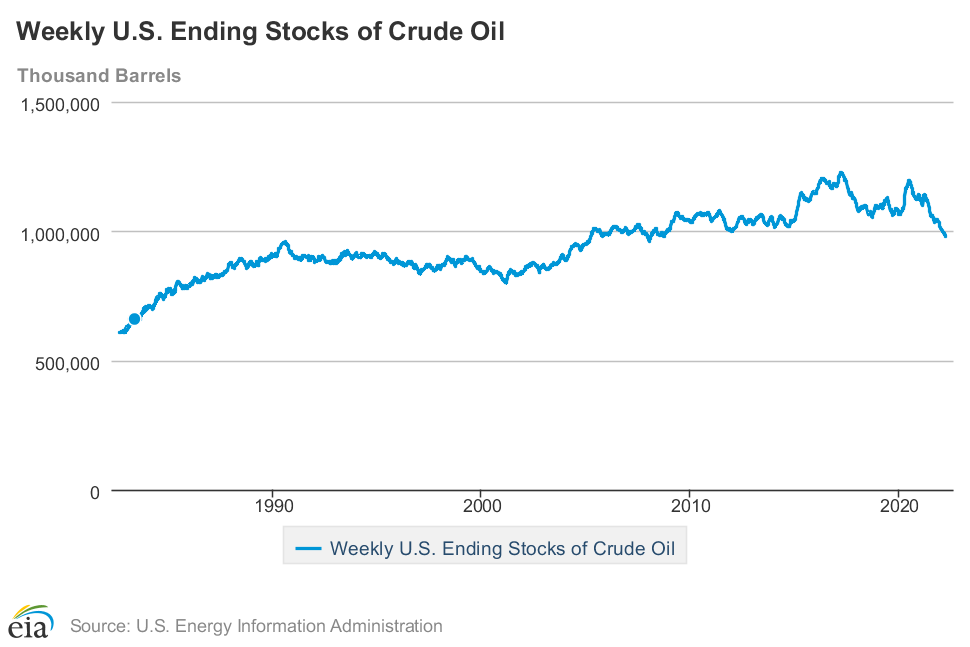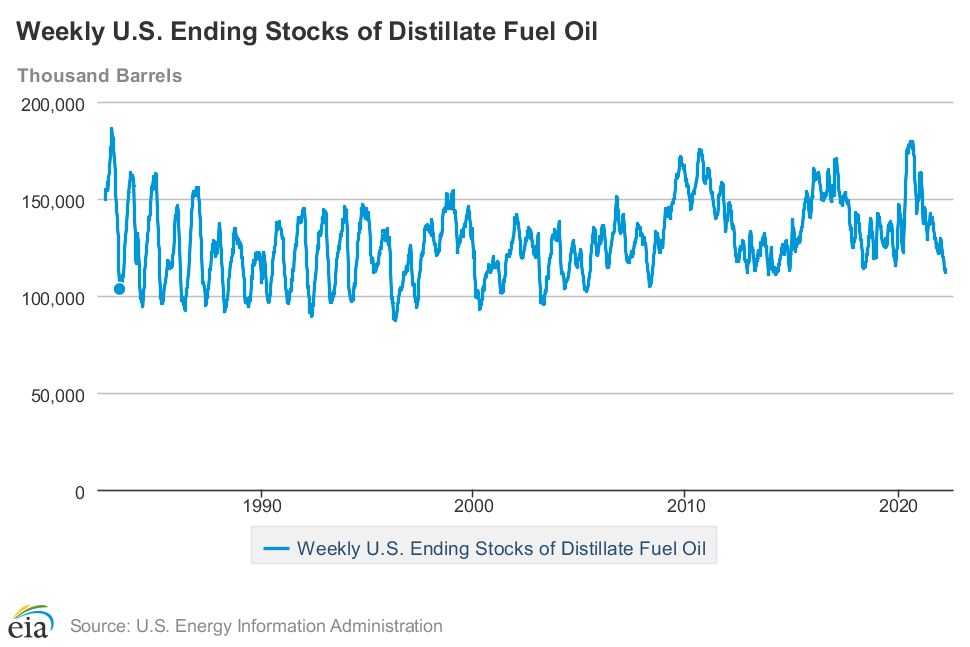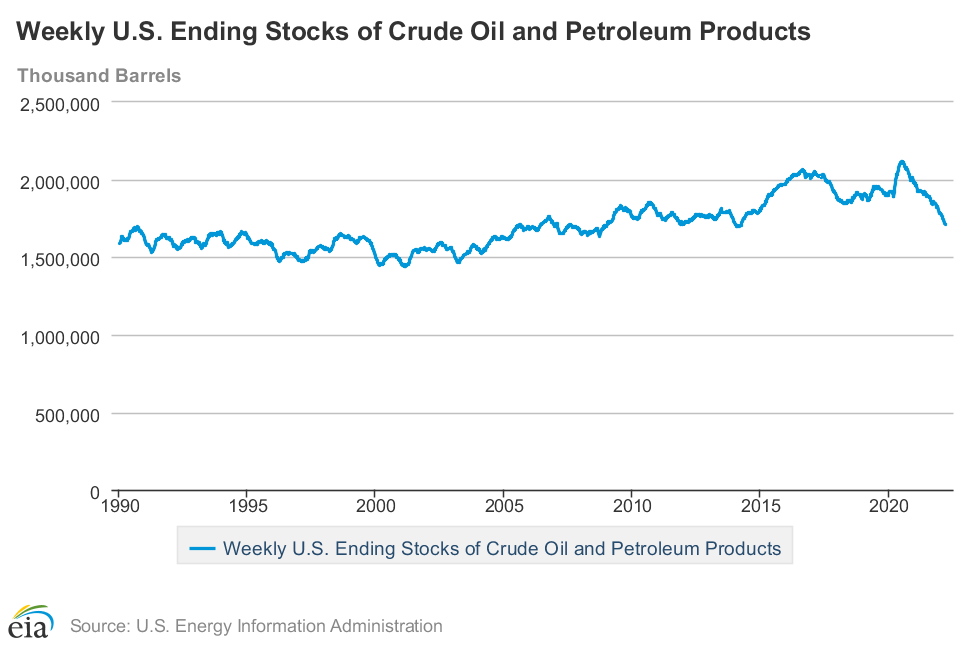RJS, Focus on Fracking US oil supplies are at a 14 – year low; commercial crude supply at a 42 month low, SPR at a 19½ year low; total oil + products supplies at a 95 month low The Latest US Oil Supply and Disposition Data from the EIA US oil data from the US Energy Information Administration for the week ending March 25th indicated that even after a big decrease in our oil exports, we had to take oil out of stored commercial crude supplies for the 13th time in 18 weeks and for the 29th time in the past forty-three weeks, as oil supply that could not be accounted for was largely absent . . . our imports of crude oil fell by an average of 227,000 barrels per day to an average of 6,259,000 barrels per day, after rising by an average of 76,000
Topics:
run75441 considers the following as important: Focus on Fracking, Hot Topics, politics, RJS, US/Global Economics
This could be interesting, too:
Robert Skidelsky writes Lord Skidelsky to ask His Majesty’s Government what is their policy with regard to the Ukraine war following the new policy of the government of the United States of America.
NewDealdemocrat writes JOLTS revisions from Yesterday’s Report
Joel Eissenberg writes No Invading Allies Act
Ken Melvin writes A Developed Taste
RJS, Focus on Fracking
US oil supplies are at a 14 – year low; commercial crude supply at a 42 month low, SPR at a 19½ year low; total oil + products supplies at a 95 month low
The Latest US Oil Supply and Disposition Data from the EIA
US oil data from the US Energy Information Administration for the week ending March 25th indicated that even after a big decrease in our oil exports, we had to take oil out of stored commercial crude supplies for the 13th time in 18 weeks and for the 29th time in the past forty-three weeks, as oil supply that could not be accounted for was largely absent . . . our imports of crude oil fell by an average of 227,000 barrels per day to an average of 6,259,000 barrels per day, after rising by an average of 76,000 barrels per day during the prior week, while our exports of crude oil fell by an average of 856,000 barrels per day to 2,988,000 barrels per day during the week, after our exports had risen 908,000 barrels per day to an 8 month high the prior week . . . applying our oil exports to offset oil supplies coming from imports to get our effective trade in oil, we find there was a net import average of 3,271,000 barrels of per day during the week ending March 25th, 629,000 more barrels per day than the net of our imports minus our exports during the prior week…over the same period, production of crude oil from US wells was reportedly 100,000 barrels per day higher at 11,700,000 barrels per day, and hence our daily supply of oil from the net of our international trade in oil and from domestic well production appears to have totaled an average of 14,971,000 barrels per day during the cited reporting week…
Meanwhile, US oil refineries reported they were processing an average of 15,913,000 barrels of crude per day during the week ending March 25th, an average of 35,000 more barrels per day than the amount of oil than our refineries processed during the prior week, while over the same period the EIA’s surveys indicated that a net of 921,000 barrels of oil per day were being pulled out of the supplies of oil stored in the US . . . so based on that reported & estimated data, this week’s crude oil figures from the EIA appear to indicate that our total working supply of oil from storage, from net imports and from oilfield production was 20,000 barrels per day less than what our oil refineries reported they used during the week . . . to account for that disparity between the apparent supply of oil and the apparent disposition of it, the EIA inserted a (+20,000) barrel per day figure onto line 13 of the weekly U.S. Petroleum Balance Sheet in order to make the reported data for the daily supply of oil and for the consumption of it balance out, a factor that they label in their footnotes as “unaccounted for crude oil”, thus suggesting there must have been an omission of that magnitude in this week’s oil supply & demand figures that we have just transcribed . . . (for more on how this weekly oil data is gathered, and the possible reasons for that “unaccounted for” oil, see this EIA explainer)….
This week’s 921,000 barrel per day decrease in our overall crude oil inventories left our total oil supplies at 978,272,000 barrels at the end of the week, the lowest inventory level since January 25th, 2008, and thus at a 14 year low . . . this week’s oil inventory decrease came as 493,000 barrels per day were being pulled our commercially available stocks of crude oil, while 429,000 barrels per day of oil were being pulled out of our Strategic Petroleum Reserve, which includes the second withdrawal under the recently announced 30,000,000 million barrel release from the SPR to address Russian supply related shortfalls, as well as an ongoing withdrawal under the administration’s earlier plan to release 50 million barrels from the SPR to incentivize US gasoline consumption . . . including other withdrawals from the Strategic Petroleum Reserve under similar recent programs, a total of 87,825,000 barrels have now been removed from the Strategic Petroleum Reserve over the past 20 months, and as a result the 568,322,000 barrels of oil still remaining in our Strategic Petroleum Reserve is now the lowest since May 10th, 2002, or at a new 19 1/2 year low, as repeated tapping of our emergency supplies for non-emergencies or to pay for other programs has already drained those supplies considerably over the past dozen years . . . based on an estimated average daily US oil consumption of 18,000,000 barrels per day, the US will have roughly 28 1/2 days of oil supply left in the Strategic Petroleum Reserve after the first two Biden administration SPR withdrawal programs have run their course…
Further details from the weekly Petroleum Status Report (pdf) indicate that the 4 week average of our oil imports rose to an average of 6,365,000 barrels per day last week, which was 11.9% more than the 5,686,000 barrel per day average that we were importing over the same four-week period last year . . . this week’s crude oil production was reported to be 100,000 barrels per day higher at 11,700,000 barrels per day because the EIA’s rounded estimate of the output from wells in the lower 48 states was 100,000 barrels per day higher at 11,300,000 barrels per day, while Alaska’s oil production rose by 14,000 barrels per day to 445,000 barrels per day, but had no impact on the final rounded national total . . . US crude oil production had reached a pre-pandemic high of 13,100,000 barrels per day during the week ending March 13th 2020, so this week’s reported oil production figure was 10.7% below that of our pre-pandemic production peak, but 38.8% above the interim low of 8,428,000 barrels per day that US oil production had fallen to during the last week of June of 2016…
US oil refineries were operating at 92.1% of their capacity while using those 15,913,000 barrels of crude per day during the week ending March 25th, up from a utilization rate of 91.1% the prior week, and somewhat higher than the historical utilization rate for late March refinery operations, when spring refinery maintenance programs are normally still winding down . . . the 15,913,000 barrels per day of oil refined this week were 6.5% more barrels than the 14,941,000 barrels of crude that were being processed daily during week ending March 26th of 2021, when refineries were still recovering from winter storm Uri, and 6.8% more than the 14,898,000 barrels of crude that were being processed daily during the week ending March 27th, 2020, when US refineries were operating at what was then a much lower than normal 82.3% of capacity at the onset of the pandemic…
With little change in the amount of oil being refined this week, gasoline output from our refineries was nonetheless quite a bit lower, decreasing by 750,000 barrels per day to 9,054,000 barrels per day during the week ending March 25th, after our gasoline output had increased by 424,000 barrels per day over the prior week . . . this week’s gasoline production was 3.1% less than the 9,339,000 barrels of gasoline that were being produced daily over the same week of last year, and 7.7% less than the gasoline production of 9,813,000 barrels per day during the week ending March 29th, 2019, to show a typical prepandemic production level . . . meanwhile, our refineries’ production of distillate fuels (diesel fuel and heat oil) increased by 120,000 barrels per day to 5,099,000 barrels per day, after our distillates output increased by 329,000 barrels per day over the prior two weeks . . . with those increases, our distillates output was 7.6% more than the 4,738, 000 barrels of distillates that were being produced daily during the week ending March 26th of 2021, and 4.7% more than the 4,870,000 barrels of distillates that were being produced daily during the week ending March 29th, 2019…
Even with the big drop in our gasoline production, our supplies of gasoline in storage at the end of the week rose for the first time in 8 weeks, increasing by 785,000 barrels to 238,828,000 barrels during the week ending March 25th,after our gasoline inventories had decreased by 2,948,000 barrels over the prior week….our gasoline supplies increased this week because the amount of gasoline supplied to US users decreased by 138,000 barrels per day to 8,499,000 barrels per day, and because our exports of gasoline fell by 450,000 barrels per day to 608,000 barrels per day while our imports of gasoline fell by 63,000 barrels per day to 656,000 barrels per day . . . and even after 7 inventory drawdowns before this week’s modest increase, our gasoline supplies were 3.6% higher than last March 26th’s gasoline inventories of 230,544,000 barrels, when shortages in the wake of Winter Storm Uri had resulted in back to back record draws, and they’re slightly above the five year average of our gasoline supplies for this time of the year…
At the same time, with this week’s increase in our distillates production, our supplies of distillate fuels increased for the second time in eleven weeks and for the ninth time in thirty weeks, rising by 1,395,000 barrels to 113,530,000 barrels during the week ending March 25th, after our distillates supplies had decreased by 2,071,000 barrels to a 95 month low during the prior week . . . our distillates supplies also rose this week because the amount of distillates supplied to US markets, an indicator of our domestic demand, fell by 712,000 barrels per day to 3,804,000 barrels per day, while our imports of distillates fell by 17,000 barrels per day to 155,000 barrels per day, and while our exports of distillates rose by 320,000 barrels per day to 1,251,000 barrels per day . . . but after thirty-five inventory decreases over the past fifty-one weeks, our distillate supplies at the end of the week were 21.2% below the 144,095,000 barrels of distillates that we had in storage on March 26th of 2021, and about 16% below the five year average of distillates inventories for this time of the year…
Meanwhile, even after the big drop in our oil exports, our commercial supplies of crude oil in storage fell for the 23rd time in 35 weeks and for the 36th time in the past year, decreasing by 3,449,000 barrels over the week, from 413,399,000 barrels on March 18th to a 42 month low of 409,950,000 barrels on March 25th, after our commercial crude supplies had decreased by 2,508,000 barrels over the prior week . . . with this week’s decrease, our commercial crude oil inventories slipped to roughly 14% below the most recent five-year average of crude oil supplies for this time of year, but were still about 28% above the average of our crude oil stocks as of the fourth weekend of March over the 5 years at the beginning of the past decade, with the disparity between those comparisons arising because it wasn’t until early 2015 that our oil inventories first topped 400 million barrels . . . since our crude oil inventories had jumped to record highs during the Covid lockdowns of spring 2020, and then jumped again after last year’s winter storm Uri froze off Gulf Coast refining, our commercial crude oil supplies as of this March 11th were 18.3% less than the 501,835,000 barrels of oil we had in commercial storage on March 26th of 2021, and were also 12.6% less than the 469,193,000 barrels of oil that we had in storage on March 27th of 2020, and 8.8% less than the 449,521,000 barrels of oil we had in commercial storage on March 29th of 2019…
Finally, with our inventory of crude oil and our supplies of all products made from oil remaining near multi year lows, we are continuing to keep track of the total of all U.S. Stocks of Crude Oil and Petroleum Products, including those in the SPR . . . the EIA’s data shows that the total of our oil and oil product inventories, including those in the Strategic Petroleum Reserve and those held by the oil industry, and thus including everything from gasoline and jet fuel to propane/propylene and residual fuel oil, fell by 1,166,000 barrels this week, from 1,708,138,000 barrels on March 18th to 1,706,972,000 barrels on March 25th, after our total supply had decreased by 10,889,000 barrels over the prior week and are now down by 81,461,000 barrels so far this year…that left our total supplies of oil & its products at the lowest since April 4th, 2014, or at a new 95 month low, despite this week’s increases in petroleum product inventories..




